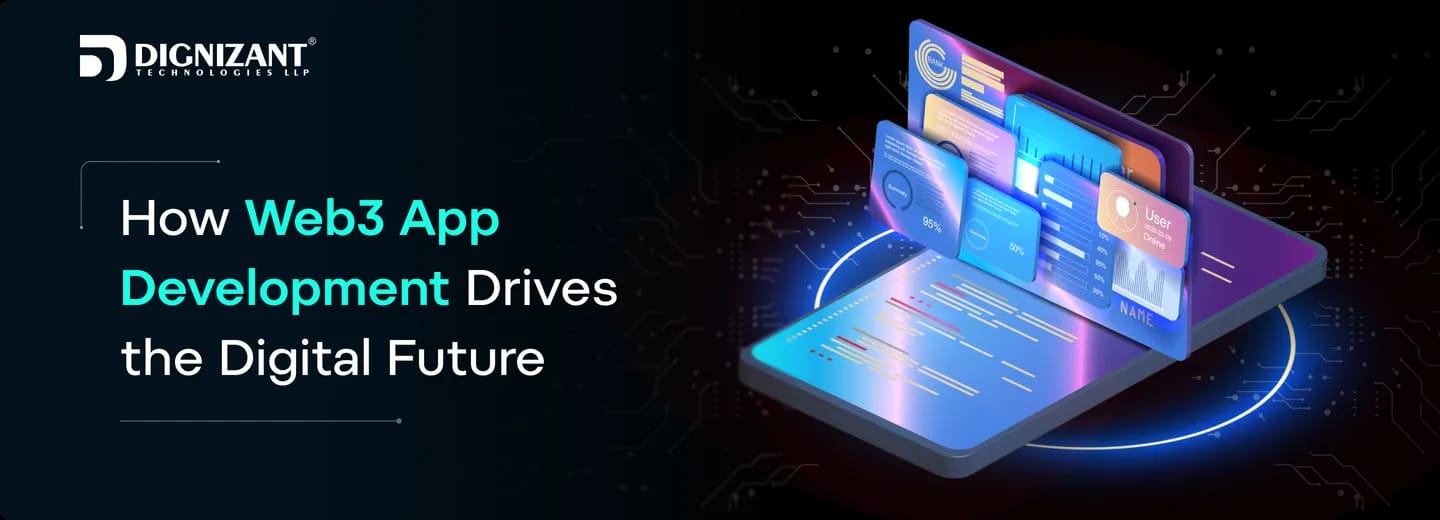How Web3 App Development Drives the Digital Future

Contributor
Palash Pandya
Uploaded
13 October, 2025
Read Time
5 Minutes
The Internet has gone through three periods of drastic paradigm shifts from static pages in Web 1.0 to social interactivity and cloud-centric ecosystems in Web 2.0. But as digital power came to be concentrated in the few tech giants, the demand for transparency, ownership and autonomy only intensified.
This demand spawned Web3, the new evolution of the internet, a decentralized, secure, transparent and user-centric one. It allows people to own their digital identities, data and assets. Central to this transformation, Web3 development companies are spearheading innovation through the most advanced Web3 app development, overhauling the way we create, communicate and trade on the internet.
What Is Web3 App Development?
Web3 app development means building dApps which run on blockchain networks instead of a centralized server. These applications leverage smart contracts self-executing contracts, with terms of the agreement directly written into lines of code to conduct transactions automatically and securely.
Unlike other mobile applications, Web3 apps don’t depend on a central authority. Instead, they are built on distributed ledgers to which all users have equal access, enhancing trustless interactions, data security and the notion of true ownership of digital assets.
Fundamentally, Web3 app dev is a reversal:
From command and control → to community governance
From platform dependency → to self-sovereign identity
From tap and exploit → to tap and empower
Core Pillars of Web3 App Development
1. Decentralization
At its heart sits decentralization, the idea of not having a single server, but spreading data and control over several nodes. This makes the reporting transparent, censorship-resistant and of higher-integrity.
For instance, instead of your photos or files being saved on one company’s server, Web3 apps rely on decentralized storage networks such as IPFS or Arweave and files are stored across nodes around the world.
2. Blockchain Technology
The blockchain is the underlying infrastructure Web3 apps sit on top of. It logs all transactions in such a way that nothing can be changed or deleted. There are some popular platforms offering blockchain potential for dApp development like Ethereum, Solana, Polygon, Avalanche that provide various advantages in terms of speed, cost and scalability.
3. Smart Contracts
Smart contracts make up the body of any Web3 application. They automate logic, making terms happen as coded word for word with no intermediaries. This automation increases transparency and reduces possibilities of human error or fraud.
4. Cryptographic Security
All transactions in Web3 are encrypted and validated by cryptography. This is not only a protection of users’ identities, but also ensures the authenticity of data and avoids unauthorized parties accessing it.
5. Tokenization and Incentives
Fungibles of non-fungibles tokens are fueling the Web3 economy. They can stand for anything currency, ownership, votes or access rights creating new models of monetization and community involvement.
The Architecture of a Web3 Application
A typical Web3 application consists of three major layers:
- Blockchain Layer:
The base layer where all transactions, computation, and state is recorded. The most popular one is still Ethereum, but there are others gaining market share fast, such as Polygon and Binance Smart Chain and Solana. - Smart Contract Layer:
The business logic layer. Smart contracts, which are written in languages such as Solidity or Rust, describe how the app behaves under certain conditions. - Front-End Interface:
The user-facing side is implemented with cutting-edge frameworks, such as React.js, Next.js, or Vue.js which connect to blockchains via tools like Web3.js, Ethers.js, or Wagmi hooks.
This construction gives the illusion that despite basically using a Web2 app like experience you are interfacing completely trustless and fully decentralized.
Why Web3 App Development Is Reshaping the Digital Future
1. True Ownership of Digital Assets
In Web2, users rent the digital space of social media accounts, gaming avatars or cloud files but they do not own it. In the world of Web3, users truly own their assets through cryptographic wallets and private keys. NFTs, for example, can be leveraged to prove ownership of digital art, in-game items or the deed to a piece of property.
2. Empowering the Creator Economy
Artists, musicians and developers will be able to cut out middlemen such as streaming platforms or app stores. With NFTs, smart contracts and DeFi, artists can earn directly on their own terms and take a bigger cut of the pie.
Example: Musicians can sell limited-edition NFTs of their songs, offering buyers exclusive access or royalties, without needing labels or distributors.
3. Financial Freedom Through DeFi
Decentralized Finance (DeFi) is perhaps one of Web3ʼs most transformative areas. Then eliminates the banks and brokers and allows peer-to-peer lending, borrowing and trading with automated smart contracts. Users can earn interest, stake assets or provide liquidity — while holding their funds themselves.
4. Transparent and Trustless Systems
The transparency of Blockchain technology enables for every transaction to be seen and validated. This makes fraud almost impossible and ensures accountability in all sectors, from finance to supply chain management.
5. Data Privacy and Control
Web3 inverts the Web2 model of data use. The users can select which data to share with whom and under what conditions thanks to decentralized identity (DID) systems. It’s a step closer to the kind of world in which privacy is a feature, not just a luxury.
6. Interoperability and Open Ecosystems
Unlike walled-garden Web2 systems, Web3 apps can connect and share data with virtually no friction. Composable app layers can be developed, where many dApps fuse together into entire systems and lead to innovation at an unprecedented pace.
How Businesses Can Benefit from Web3 Application Development
Companies thinking ahead have already started using Web3 as a competitive advantage:
Increased Customer Confidence: Invencoin systems are transparent and auditable to build greater customer confidence.
New Revenue Opportunities: Tokenization, NFTs, and DeFi models enable new ways to monetize.
Ownership and Compliance Costs: Web3’s user-first design lowers proprietary data compliance costs (GDPR, CCPA).
Community-Powered Growth: By means of tokens, DAOs and incentives, companies can create a following.
Conclusion:
Web3 isn’t just hype, it’s the blueprint for what the future of digital is going to look like. It is the transfer of power from intermediaries to users, from central organizations to decentralized communities. Today, Web3 development companies are driving this transition by constructing decentralized applications delivering ownership, transparency and trust to users in all of their digital interactions.
As Web3 application development matures, it has the potential to deliver an internet where privacy, transparency and ownership live in peaceful coexistence. Whether that’s redefining social media, reshaping finance or empowering creators Web3 is pioneering the next wave of innovation.
Latest Articles

Build secure, intelligent financial platforms with advanced fintech web development designed for speed, compliance and exceptional user experience.

Unlock mobile success by selecting the Best Tech Stack that boosts reliability, enhances UX, and supports long-term app evolution.

Boost web performance and loading speed through expert Performance Optimization in Python techniques for faster, scalable, and efficient applications.
FAQs
Ready to Take Your Business to the Next Level?
Unlock new opportunities with expert solutions designed to elevate your brand. From strategy to execution, we empower your business with the tools, technology and talent it needs to thrive in today’s digital world.



